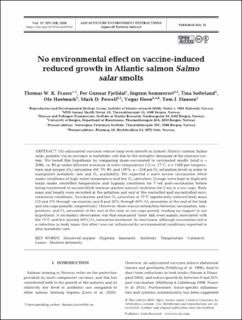No environmental effect on vaccine-induced reduced growth in Atlantic salmon Salmo salar smolts
Fraser, Thomas; Fjelldal, Per Gunnar; Sommerset, Ingunn; Søfteland, Tina; Høstmark, Ole; Powell, Mark; Heen, Vegar; Hansen, Tom Johnny
Peer reviewed, Journal article
Published version
Permanent lenke
https://hdl.handle.net/11250/2719614Utgivelsesdato
2020Metadata
Vis full innførselSamlinger
- Articles [3008]
- Publikasjoner fra CRIStin [3053]
Sammendrag
Oil-adjuvanted vaccines reduce long-term growth in farmed Atlantic salmon Salmo salar, possibly via an increase in metabolic rate due to the energetic demands of the immune system. We tested this hypothesis by comparing sham-vaccinated to vaccinated smolts (total n = 2096, ca. 80 g) under different scenarios of water temperature (12 vs. 17°C, n = 1048 per temperature) and oxygen (O2) saturation (60, 70, 80, and 100%, n = 524 per O2 saturation level) in order to manipulate metabolic rate and O2 availability. We expected a more severe vaccination effect under conditions of high water temperature and low O2 saturation. Groups were kept in duplicate tanks under controlled temperature and hypoxia conditions for 7 wk post-vaccination before being transferred to uncontrolled common-garden natural conditions for 5 mo in a sea-cage. Body mass and length were recorded at the initiation and end of the controlled and uncontrolled environmental conditions. Vaccination and low O2 saturation at 17°C significantly reduced body mass (13 and 3% through vaccination and 9 and 20% through 60% O2 saturation at the end of the tank and sea-cage periods, respectively). However, there was no interaction between vaccination, temperature, and O2 saturation at the end of the tank or sea-cage period, lending no support to our hypothesis. A secondary observation was that emaciated ‘loser’ fish were mainly associated with the 17°C and low (mainly 60%) O2 saturation treatment. In conclusion, although vaccination led to a reduction in body mass, this effect was not influenced by environmental conditions expected to alter metabolic rate.
